Muscle Strains
Muscle Strains.... the curse of every athletes season
They usually occur at the most inconvenient moment and more often than not, they can disrupt training for weeks in less severe cases and for two or more months in more significant incidents.
Muscle injuries vary in their severity from mild muscle damage (grade I), more severe muscle fibre tearing (grade II) and in some cases complete tears (grade III).
The most prevalent field sport injury is a hamstring strain, owing to the high volume of training/games and exposure to lots of high speed running.
The vast majority of muscle strains are non-contact so as you can imagine there are a number of factors involved.
There is still a belief among many that most injuries can be put down to lack of flexibility or an inadequate warm-up. If it was that simple and straightforward, professional sports teams wouldn’t invest so much in a team of physiotherapy staff and strength & conditioning coaches.
There are a number of factors at play in a muscle strain injury, and these apply to areas other than the hamstring such as hip flexor, groin and calf strains.
When talking about these “factors” or “risk factors” we like to divide these into “modifiable” (factors which you can change) and “non-modifiable” (those that are out of your control).

Non-modifiable risk factors for muscle strains are older age and previous muscle strain. In fact, there is up to a 600% increased risk of a hamstring strain if you have had a previous hamstring strain (Mendiguchia et al, 2012).
This increased risk can be explained by inadequate rehab, where players return to playing while they still are not at their baseline strength and flexibility measures.
You can get back playing without completing your rehab fully, but if you still have deficits in certain areas of strength and mobility you are leaving yourself at high risk for injury recurrence.
So although the previous injury is non-modifiable in one sense, there are steps you can take to reduce your risk of recurrence.
So What Can You Control?
The modifiable risk factors comprise a much longer list:
- Recovery
- Strength
- Flexibility
- Lumbopelvic (Core) Control
- High Training Load
Recovery encompasses Sleep and Nutrition.
Most athletes are well versed in how to eat to recover, incorporating foods rich in protein and carbohydrates.
Often overlooked is the role of sleep. Research has shown there is a 70% increased risk of injury if an athlete sleeps for less than 7 hours per night.
Adequate strength and flexibility are also important variables, and the addition of strength exercises such as the Nordic Hamstring Curl has been shown to decrease hamstring strains by 50%.
Although seen as a strength exercise it can significantly improve hamstring flexibility and even increase acceleration speed!
This is because it incorporates an “eccentric muscle contraction” where the muscle is lengthening as it’s contracting.
As you can see there is a long list of things to be assessed and addressed, this is why getting a thorough physiotherapy assessment is very important.
Carrying A New Or Old Strain?
Why Not Apply For A Free Strategy Session
Interested in Improving Your Performance & Staying Injury Free?
Optimising Training Load is also vitally important.
If you’d like to find out more about injury prevention and performance, why not sign up to our FREE Email Series with the most up to date, evidence based advice and tips.